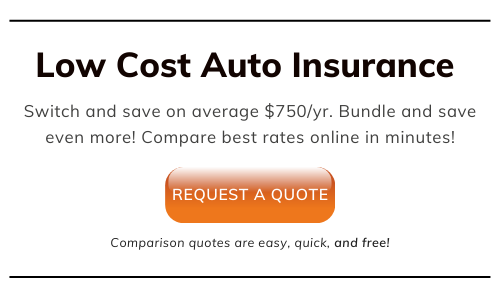What Are The Different Types of Car Insurance?
Free Insurance Comparison
Compare Quotes From Top Companies and Save
Secured with SHA-256 Encryption
When we talk about car insurance, we typically refer to it as if it’s a single product. In a general sense, that’s true. But more specifically, car insurance is something of an umbrella policy that can have as many as a dozen different sub-policies in certain cases.
To show you all the moving parts of a car insurance policy – and to help you be a better, more informed consumer – let’s break down the many different components of that insurance product we simply refer to as “car insurance”.
Table of Contents:
State Minimum Car Insurance Requirements
Before we get into the many types of car insurance, you should know the minimum legal insurance requirements in your state before shopping for a policy. Coverage requirements can vary substantially from one state to the next, and while some types of coverage may be required in your state, others may not.
Every state in the US requires drivers to have car insurance. The only exception is New Hampshire, but even in the Granite State you’ll be required to have coverage if you have a loan on your car.
Like virtually every other industry, the car insurance industry has its own “language”. State minimum coverage requirements are usually expressed as three numbers. That will look something like 25/50/25.
Each of those numbers represent coverage in thousands. For example, it would be more accurate to show it as $25,000/$50,000/$25,000. But the XX/XX/XX seems to be some sort of commonly accepted industry shorthand.
The three numbers represent the minimum required coverage for the following parts of your car insurance policy:
- Bodily injury liability maximum for one person injured in an accident
- Bodily injury liability maximum for all injuries in one accident
- Property damage liability maximum for one accident
Please keep in mind when shopping for car insurance that the state minimum requirements are just that, minimums. They may represent an acceptable level of insurance for a young driver with no assets, looking for lowest possible premium. But if you’re older than 25, and you have significant assets – like a house and savings – you’ll need higher coverage.
That’s because one of the primary reasons for car insurance is to protect your assets if you’re in an accident that’s your fault. The higher coverage amounts will do that.
Let’s move on to the many types of car insurance.
Enter your ZIP code below to view companies that have cheap insurance rates.
Secured with SHA-256 Encryption
The Big Three: Liability, Collision and Comprehensive
These are the policy types most consumers are most familiar with. But they may not always be aware of exactly what each does.
Liability
Liability is the core coverage in every car insurance policy. It will pay a claim if you’re involved in an accident where you’re determined to be at fault. That can include personal injury to the occupants of the other vehicle, as well as damage to their car.
It essentially represents the 25/50/25 (or similar) equation outlined above, providing for bodily injury liability and property damage liability.
It’s important to remember this part of your coverage will pay the other party, not you. But if the situation is reversed, where you’re in an accident that’s the other party’s fault, their liability coverage will pay you.
Collision
Collision covers the cost of repairs for damage to your vehicle whether you or the other party are determined to be at fault. It does not pay for damage sustained by the other driver, but that’s what liability is for.
Collision may not be required by your state, but it will be required by your lender if you have a loan on the vehicle. The lender will want to make certain that your car will be fully repaired if you’re in an accident, to protect the value of their collateral.
You may not need collision if you don’t have a loan on your vehicle, or if the car is old and of little value. For example, if your car is worth less than $2,000, the cost of the collision coverage may exceed the benefit of the provision if your car is totaled.
Read more: Comprehensive vs Collision: What You Need to Know
Comprehensive
Comprehensive is probably more mysterious than collision because the word “comprehensive” isn’t especially descriptive. It works similar to collision, except that while collision covers damage to your vehicle while it’s moving, comprehensive covers damage that happens when the car is parked.
For example, comprehensive will pay if your car has been stolen. It will also cover damage to your vehicle from natural disasters, like hurricanes and earthquakes. It’ll even pay if a tree limb breaks off and falls on your car, crushing the roof.
Think of it as collision = movement, comprehensive = parked.
Other Car Insurance Coverages
There’s a long list of other car insurance types in this group, and you’re probably not familiar with most of them. Some will be state minimum requirements, while others fall in the “nice to have” category. Here are the primary ones:
Uninsured Motorist Coverage
This is the coverage type in which the car insurance company will pay your medical expenses if either you or passengers in your vehicle are injured in an accident caused by a person who doesn’t have car insurance. It will also pay for repairs for damages sustained by your vehicle.
Even though it’s illegal to drive without car insurance in most states, it’s not exactly uncommon. If you have the misfortune to be in an accident caused by someone without insurance, you’ll be really glad you have this provision in your policy.
Uninsured motorist coverage has two parts:
- Uninsured motorist bodily injury coverage: Covers you and your passengers for medical expenses, lost wages and pain and suffering that are the result of an accident with an uninsured driver. It also covers injuries from a hit-and-run collision.
- Uninsured motorist property damage coverage: Covers damage your car as a result of an accident caused by an uninsured driver.
Uninsured motorist coverage is required in most states. Even though it will increase your premium, it’s coverage is well worth having.
Under-insured Motorist Coverage
Remember we talked about state car insurance minimum requirements? Let’s say you get into an accident with someone who has the minimum coverage required by law. It might meet state law, but it may not be sufficient to fully cover an accident caused by that driver.
For example, the third number in that 25/50/25 liability requirement is property damage liability maximum for one accident. That means the driver has $25,000 to cover damage to your vehicle if he is at fault in the accident.
But you just bought a brand-new car for $50,000, and the accident caused by the driver totaled your vehicle. The at-fault driver’s policy will only cover $25,000. The remaining balance will be covered by your own under-insured motorist coverage.
Like uninsured motorist coverage, under-insured motorist coverage is well worth having, even if it isn’t required by state law.
Personal Injury Protection (PIP)
This is commonly referred to as “no-fault” coverage. It pays for bodily injury claims in accidents where fault can’t be determined. It not only pays for medical expenses (not covered by health insurance) sustained in the accident, but also covers lost income, childcare, and payment for funeral arrangements.
PIP isn’t required in most states, but it’s an excellent provision to have. It’ll come in handy if you’re involved in an accident where the only “evidence” is he said/she said. It’s also an excellent provision if you don’t have health insurance at all.
Personal Umbrella Policy (PUP)
Remember how I said you should have more than the state mandated minimum coverage if you have substantial assets? Most conventional car insurance policies limit liability coverage to no more than $300,000. If you’re worth more than that, you may want to add a PUP provision to your policy.
It can add $1 million or more in additional protection in case you’re hit with a lawsuit from an accident where you’re determined to be at fault.
Guaranteed Auto Protection (GAP)
Do you know how many auto loans are available for 100% or more of the value of the vehicle you’re buying? If you have that kind of financing arrangement, you’re almost certainly what’s known as upside down on your car. That’s a car industry term that describes a person who owes more on their vehicle than the vehicle is worth.
If that describes you, you’ll need GAP coverage.
Let’s say you purchase a car for $30,000 with 100% financing. As soon as you drive the car off the lot it’s worth maybe $27,000. But a block away from the dealership you’re hit hard by a pickup truck driving 30 miles over the limit. Your car is totaled.
Car insurance will only cover up to the value of the vehicle – $27,000. But since you still owe $30,000 to the lender, you’ll need to come up with $3,000 out-of-pocket to satisfy the loan.
But if you have GAP coverage, the shortfall will be covered by the insurance company.
GAP isn’t a standard provision, but highly recommended for anyone who’s even close to being upside down on their vehicle.
Rental Reimbursement
This is a car insurance provision that will provide reimbursement for a rental vehicle while your car is being repaired as part of an insurance claim.
They typically have limits, such as $30 per day, and may even require you to rent from a specific car rental company. But it’s excellent coverage to have since repairs from major accidents can take weeks.
Which Type of Car Insurance Do You Need?
Not all the policy types listed above will be required by your state, but they’re still good to have. Even though each will raise the premium on your policy, it’ll seem like a small price to pay if you encounter any of the covered events.
Always remember that the entire purpose of car insurance is to protect from the unexpected.
The more policy provisions you have – and the higher the dollar amount of the coverage – the better you’ll be protected. That’s a lot more important than simply getting the lowest car insurance premium. (For more information, read our “Do You Need Car Insurance In The United States?”)
Homeowners insurance is one of the most important types of insurance you can own. Getting the best policy for you and your home requires research, comparison, and attention to detail. Fortunately, those are some of the few things we love more than talking about insurance!
In this post, we’ll help you understand the eight different types of homeowners insurance policies. If you are looking for a policy, here are the best homeowners insurance companies for you, based on our research.
To keep learning before you buy, here is some insight on the different levels of coverage.
The 8 Basic Homeowner’s Insurance Policies
Similar to other types of property insurance, homeowners insurance coverage has multiple sections and coverage types.
Homeowners insurance policies can have up to five components, including:
- Homeowners Insurance
- Homeowners Insurance Coverage
- Best Homeowners Insurance Companies
- Hazard Insurance vs Homeowners Insurance: What’s the Difference?
- Sweet or Sour? Is Lemonade Renters Insurance Good? (or Bad)
- Best Reddit Reviews of Lemonade Insurance (Customer Stories)
- Lemonade Renters Insurance Review: Cost, Coverage, and More
- Company Reviews
- Coverage A – Dwelling Protection
- Coverage B – Other Structures
- Coverage C – Personal Property
- Coverage D – Additional Living Expenses
- Coverage E – Personal Liability
Dwelling Protection
Provides insurance for damage or loss of your home.
Coverage A is not included in a renters insurance policy nor a condo policy in which only interior damage is covered.
Other Structures
This coverage provides insurance for damages to or loss of any other structures you may have on your property, including a detached garage, a woodshed, fencing, swimming pool, and trampolines, to name a few.
This is automatically included in your homeowner’s insurance policy even if you do not have other structures on your property.
Personal Property
This covers your personal belongings such as furniture, clothing, entertainment system, etc., anything that is not permanently affixed to your home.
Personal property coverage is automatically included in most of the coverage types.
It is recommended to get 50% to 75% of dwelling coverage for personal property coverage.
Additional Living Expenses
These are costs you may incur if you have to temporarily relocate because your home is unlivable as a result of the covered damage.
Personal Liability
This protects you against a claim filed against you for injury or property damage if someone is injured while on your property.
This usually starts at $100,000 of coverage, but you can increase the coverage amount if you need more liability.
Enter your ZIP code below to view companies that have cheap insurance rates.
Secured with SHA-256 Encryption
What Is A Peril?
Each type of coverage specifically lists perils that are covered as well as perils not covered in the policy.
For instance, the basic policy typically only covers 11 of the 16 perils.
Covered Perils Include:
- Fire or smoke
- Lightning
- Windstorm or hail
- Explosion
- Riot or civil commotion
- Damage caused by aircraft
- Damage caused by vehicles
- Smoke
- Vandalism or malicious mischief
- Theft
- Volcanic eruption
- Falling object
- The weight of ice, snow or sleet
The Most Common Excluded Perils:
- Floods
- Earthquakes
- Hurricanes (flooding)
- Mold
- Infestations
- Neglect
Named Peril
This means that your policy only covers the perils listed in your policy but does not cover those specifically listed as excluded. For instance, earthquakes and floods are generally excluded from almost all policy types.
Open Peril
This is a broader policy type because it covers all perils except for those perils excluded in the policy.
Open-peril policies are typically more expensive than named perils but are more comprehensive and provide broader coverage.
Types Of Replacement Cost Coverages

1 – Actual Cash Value
This pays for your home or personal possessions based on market value, or after depreciation is deducted.
2 – Replacement Cost
This pays for the cost of rebuilding or repairing your home or replacing possessions without a depreciation deductible applied.
3 – Guaranteed/Extended Replacement Cost
This policy pays you above the cash value of your property. Many times, the replacement coverage is 125% of the stated limit of coverage.
This policy type is not available in all states and is the most expensive of the replacement policies.
What are the 8 Types of Homeowners Insurance Coverages?
1 – HO-1, Basic Form
This is the basic, named-peril homeowners insurance policy form. It is the least expensive but also offers the least amount of coverage.
Typically, the following perils are covered under a basic form policy:
- Fire or smoke
- Explosions
- Lightning
- Hail and windstorms
- Theft
- Vandalism
- Damage from vehicles
- Damage from aircraft
- Riots and civil commotion
- Volcanic eruption
This type of coverage mostly covers dwelling protection. With some homeowners insurance carriers, you can add on personal property coverage, and/or liability.
2 – HO-2, Broad Form
This named-peril policy covers all of the perils covered in the basic form, plus the following perils:
- Falling objects
- The weight of ice, snow, or sleet
- Freezing of household systems such as heater or air conditioning unit
- Sudden and accidental damage to pipes or other household systems
- An accidental overflow of water or steam
- Sudden and accidental damage from an electrical current (artificially generated)
The broad form usually covers dwelling protection, other structures, personal belongings, and liability. This type, however, only provides coverage for the named perils listed in the policy.
3 – HO-3, Special Form
This is the most common type of homeowner’s insurance coverage due to its affordability and coverage.
To start, it covers all of the perils listed in the HO-2 policy and more.
It is a named peril policy, so it protects you against any and all perils except any specifically excluded in your policy.
The special form covers your property, personal belongings, and liability protection.
Common perils excluded are earthquakes and floods.
4 – HO-4, Tenant’s Form
This is a renters policy for home insurance. Under this policy, as a renter, your personal belongings and personal liability are covered.
The home itself is not because it is covered by the owner’s home insurance.
Additional living expenses can sometimes be added to the tenant’s form policy.
5 – HO-5, Comprehensive Form
This policy often covers more perils than any other policy type.
It is an open peril policy for both property and liability, and it covers all perils except any specifically listed as exclusions on the policy.
Common perils excluded include earthquake (or earth movement) and floods.
This is the broadest form of homeowner’s insurance available. It is more expensive than HO-3, but it does provide more comprehensive coverage.
6 – HO-6, Condo Form
If you own a condo, this is the type of coverage you need. It provides protection of your personal belongings, personal liability, and for the interior of your condo, including the walls, floors, and ceilings.
7 – HO-7, Mobile Home Form
This policy is for mobile or manufactured homes only. It has the same coverage as HO-3, but is designed specifically for these types of homes.
8 – HO-8, Older Home Form
This type of policy is specifically for older homes (age classified by the insurance carrier) and offers the same protections as HO-3 but with modifications to address the differences that may exist in an older home.



